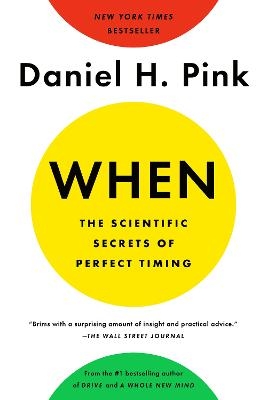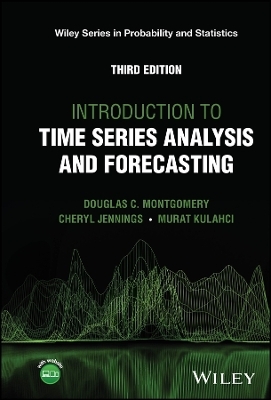
When: The Scientific Secrets of Perfect Timing
Riverhead Books,U.S. (Verlag)
978-0-525-54278-0 (ISBN)
#1 Wall Street Journal Business Bestseller
Instant Washington Post Bestseller
"Brims with a surprising amount of insight and practical advice." --The Wall Street Journal
Daniel H. Pink, the #1 bestselling author of Drive and To Sell Is Human, unlocks the scientific secrets to good timing to help you flourish at work, at school, and at home.
Everyone knows that timing is everything. But we don't know much about timing itself. Our lives are a never-ending stream of "when" decisions: when to start a business, schedule a class, get serious about a person. Yet we make those decisions based on intuition and guesswork.
Timing, it's often assumed, is an art. In When: The Scientific Secrets of Perfect Timing, Pink shows that timing is really a science.
Drawing on a rich trove of research from psychology, biology, and economics, Pink reveals how best to live, work, and succeed. How can we use the hidden patterns of the day to build the ideal schedule? Why do certain breaks dramatically improve student test scores? How can we turn a stumbling beginning into a fresh start? Why should we avoid going to the hospital in the afternoon? Why is singing in time with other people as good for you as exercise? And what is the ideal time to quit a job, switch careers, or get married?
In When, Pink distills cutting-edge research and data on timing and synthesizes them into a fascinating, readable narrative packed with irresistible stories and practical takeaways that give readers compelling insights into how we can live richer, more engaged lives.
lt;b>Daniel H. Pink is the author of several books including the New York Times bestsellers Drive, To Sell is Human, and A Whole New Mind. His books have won multiple awards and have been translated into 35 languages. He lives with his family in Washington, DC.
1.
The Hidden Pattern of Everyday Life
What men daily do, not knowing what they do!
William Shakespeare, Much Ado About Nothing
If you want to measure the world s emotional state, to find a mood ring large enough to encircle the globe, you could do worse than Twitter. Nearly one billion human beings have accounts, and they post roughly 6,000 tweets every second. The sheer volume of these minimessages what people say and how they say it has produced an ocean of data that social scientists can swim through to understand human behavior.
A few years ago, two Cornell University sociologists, Michael Macy and Scott Golder, studied more than 500 million tweets that 2.4 million users in eighty-four countries posted over a two-year period. They hoped to use this trove to measure people s emotions in particular, how positive affect (emotions such as enthusiasm, confidence, and alertness) and negative affect (emotions such as anger, lethargy, and guilt) varied over time. The researchers didn t read those half a billion tweets one by one, of course. Instead, they fed the posts into a powerful and widely used computerized text-analysis program called LIWC (Linguistic Inquiry and Word Count) that evaluated each word for the emotion it conveyed.
What Macy and Golder found, and published in the eminent journal Science, was a remarkably consistent pattern across people s waking hours. Positive affect language revealing that tweeters felt active, engaged, and hopeful generally rose in the morning, plummeted in the afternoon, and climbed back up again in the early evening. Whether a tweeter was North American or Asian, Muslim or atheist, black or white or brown, didn t matter. The temporal affective pattern is similarly shaped across disparate cultures and geographic locations, they write. Nor did it matter whether people were tweeting on a Monday or a Thursday. Each weekday was basically the same. Weekend results differed slightly. Positive affect was generally a bit higher on Saturdays and Sundays and the morning peak began about two hours later than on weekdays but the overall shape stayed the same. Whether measured in a large, diverse country like the United States or a smaller, more homogenous country like the United Arab Emirates, the daily pattern remained weirdly similar.
Across continents and time zones, as predictable as the ocean tides, was the same daily oscillation a peak, a trough, and a rebound. Beneath the surface of our everyday life is a hidden pattern: crucial, unexpected, and revealing.
Understanding this pattern where it comes from and what it means begins with a potted plant, a Mimosa pudica, to be exact, that perched on the windowsill of an office in eighteenth-century France. Both the office and the plant belonged to Jean-Jacques d Ortous de Mairan, a prominent astronomer of his time. Early one summer evening in 1729, de Mairan sat at his desk doing what both eighteenth-century French astronomers and twenty-first-century American writers do when they have serious work to complete: He was staring out the window. As twilight approached, de Mairan noticed that the leaves of the plant sitting on his windowsill had closed up. Earlier in the day, when sunlight streamed through the window, the leaves were spread open. This pattern leaves unfurled during the sunny morning and furled as darkness loomed spurred questions. How did the plant sense its surroundings? And what would happen if that pattern of light and dark was disrupted?
So in what would become an act of historically productive procrastination, de Mairan removed the plant from the windowsill, stuck it in a cabinet, and shut the door to seal off light. The followi
| Erscheinungsdatum | 21.12.2018 |
|---|---|
| Sprache | englisch |
| Maße | 105 x 171 mm |
| Gewicht | 147 g |
| Themenwelt | Sachbuch/Ratgeber ► Gesundheit / Leben / Psychologie ► Lebenshilfe / Lebensführung |
| Geschichte ► Hilfswissenschaften ► Chronologie | |
| Geisteswissenschaften ► Psychologie ► Sozialpsychologie | |
| Naturwissenschaften ► Physik / Astronomie ► Astronomie / Astrophysik | |
| Wirtschaft ► Betriebswirtschaft / Management ► Unternehmensführung / Management | |
| Schlagworte | bestseller list • books bestsellers • business • business books • Daniel Pink • dan pink • drive book • Financial Planning • gifts for dad • gifts for her • gifts for him • gifts for mom • Habit • holiday gifts • inspirational gifts • leadership books • life planning • management books • new years resolution • non fiction bestsellers • nonfiction best sellers • physics gifts • Pink • pink books • planner • Productivity • Psychology • psychology books • scheduler • Science • science books • Self Help • Self-Help • self help books • stop light • the power of when • timing book • To Sell Is Human • when • when book |
| ISBN-10 | 0-525-54278-7 / 0525542787 |
| ISBN-13 | 978-0-525-54278-0 / 9780525542780 |
| Zustand | Neuware |
| Haben Sie eine Frage zum Produkt? |
aus dem Bereich


